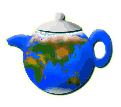
 |
|||||
|
|
|
|
|
|
|
High Teaby Hardy Haberman |
|
|
Though it sounds like a creation of the irrepressable Hyacinth Bucket (of the BBC's
Keeping Up Appearances),
High Tea originated as a British working class tradition. "High" refered to the way it was taken,
sitting atop stools in a tea shop or standing at a counter or buffet table. It was a cross between afternoon tea
and supper, and for many it was the main meal of the day.
Today, it has become a more elegant affair. Now served in many restaurants and hotels across the world,
this affair has become less a working class meal and more of an event. In some cities, it is a "power"
business event. Having High Tea with a client is preferred to the more traditional "night out" and offers
a much better atmosphere for discussing business.
When to serve it? The high time of the day, around 3 or 4 o'clock in the afternoon.
What to serve? Tea sandwiches for starts, but traditional British High Teas might include Welsh Rabbit, Scotch
Woodcock and other meat and fish dishes. Also, puddings, cakes, crumpets and scones served with jellies,
marmalades and spreads of various kinds.
What kind to serve? There are more than 1,500 varieties grown in dozens of countries however the prominent
producers are China, India, Kenya, Sri Lanka, Malawi, and Indonesia . With so many to choose from a variety
selection seems only fitting. Though herbal and fruit infusions have become popular they are not classified as true
"teas", and purists will recoil from their inclusion at the table. Why? It's the civilized thing to do. The tradition of afternoon tea offers a pleasant break in the day, a chance for conversation, relaxation and of course a good cup of tea!
Tea Importers
Books
|
Major Classifications
White
A very rare variety made from only the plant's buds. These are usually dried and packaged
without any further processing. Included in this classification are:
Green
This one is harvested by hand in Japan. The stems are removed and the leaves are rolled on a heated plate
to give it the curled appearance. These are then placed in paper trays and set over a charcoal fire to dry
them completely. Included in this classification are:
Oolong
A semi-fermented tea whose leaves are rolled and allowed to begin the fermentation process. Once the edges
of the leaves trun brown, they are heat dried to stop the fermentation process. Included in this classification are:
Black
These are allowed to wither naturally in trays. After about eighteen hours they are rolled to bruise
the leaf. This starts the fermentation. Leaves turn dark brown during fermentation and begin to release
the familiar "black tea" scent. When the leaves have fermented to the desired level, they are
fire-dried to stop the fermentation process. These are frequently named for the region in which they
are grown. Included in this classification are:
Specialty Blends
Related Web Sites
|
| Where to go | |
| Here are a few of the grand places If you have additional suggestions, please email us with the information. | |
|
The Bellevue Hotel
Beverly Hills Hotel
Biltmore Hotel
The Charleston Place Hotel
The Copley Plaza Hotel
The Fairmont Empress Hotel
The Four Seasons Hotel
Imperial Tea Court
Magnolia & Ivy Tea Parlors |
J. P. Morgan Library
Neiman Marcus
The Peabody Hotel
The Ritz-Carlton Chicago
The Seasons Restaurant
The Waldorf-Astoria
The Willard Hotel
Windsor Court Hotel
 |
|
|
||||
|
Copyright © 2007 Epicurean.com All rights reserved |